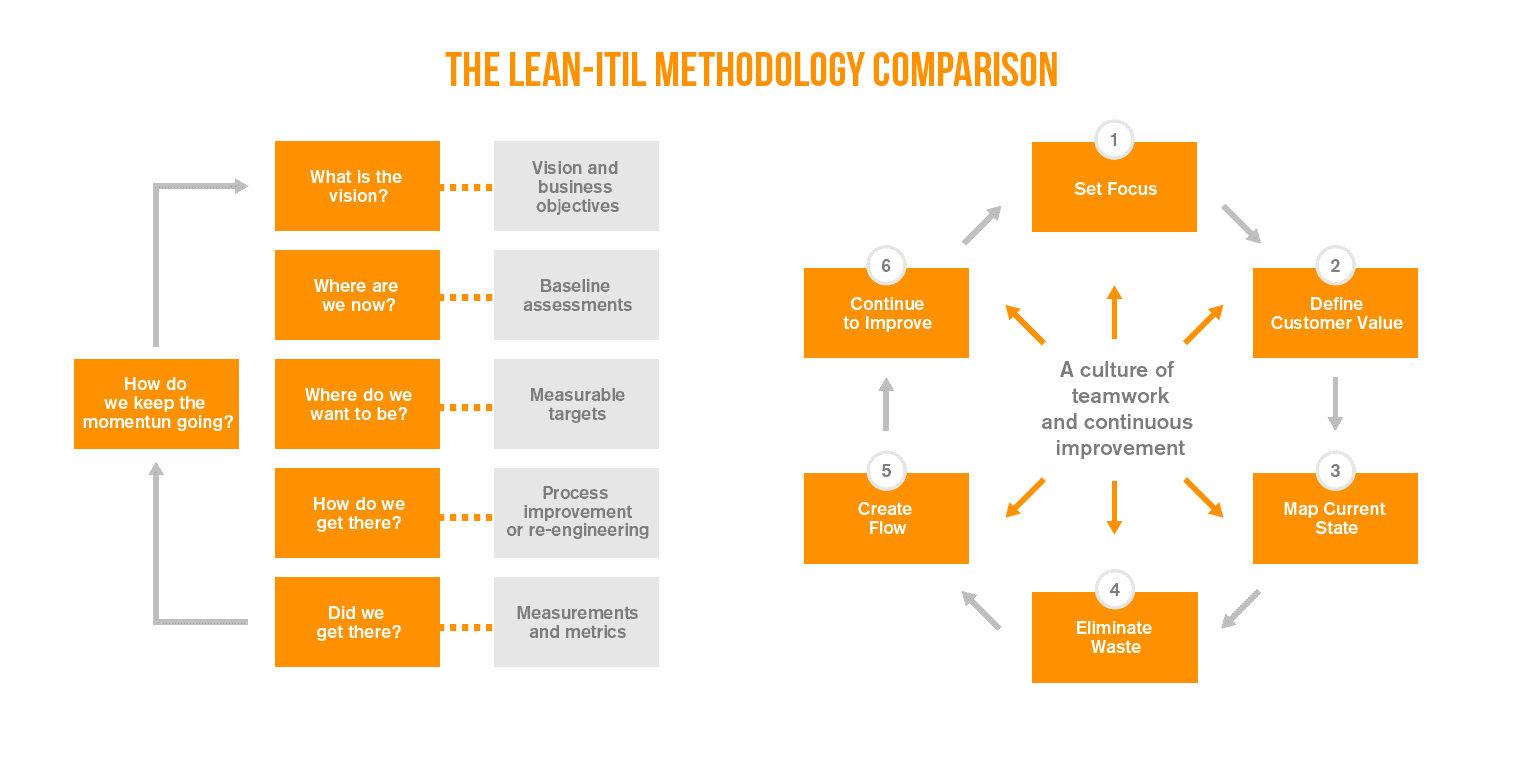Blending Lean IT with ITSM to create customer and employee value
An overview of the shared principles and best practices
06 mins read
I'd been an IT service management (ITSM), Operations, senior IT leader, and consultant for over 30 years before being asked to use Lean IT. My response was what is lean? Do I need a diet?
My CIO sent me to Paris to attend the first Lean IT conference hosted by Steve Bell and Mike Orzen - the authors of LeanIT. I also met Michael Balle, lean sensei and creator of a series of books I would end up featuring in - The Goldmine Trilogy. Lean is the term Daniel Jones and James Womack used to describe Toyota's practices of creating value customer services, as learned from Goldratt and Demming.
Michael Balle considers Lean to be "the passion for what we do expresses itself as a relentless drive to deliver more value - to customers, partners, and ourselves. Discipline in the lean sense is not about rigidly enforcing rules or "best practices," but having the personal will to take a step back, think about what our best response should have been, and compare it to what we did and why."
In today's rapidly evolving technological landscape, organizations must find effective ways to deliver value and meet customer needs. Despite some misconceptions, Lean IT and ITSM are not at odds but complement each other. This article will explore the cultural match between Lean IT and the ITSM movement, highlighting their shared principles and best practices.
The Foundations of Lean IT
Lean IT focuses on continuous improvement, respect for people, and eliminating waste. It is not a specific set of tools or techniques but a way of thinking about IT management.
The foundational principles of Lean IT
- Value Identification: Identify what the customer values, where value is any action or process that directly contributes to meeting customer needs or requirements.
- Value Stream Management: Value is any action or process that meets customer needs or requirements. Value Steam Management (VSM): identifies bottlenecks, redundancies, and areas for improvement by visualizing the end-to-end processes that deliver value to customers by mapping the tasks that occur to provide and sustain customer value.
- Flow Optimisation: The outcome of VSM is the improved flow of work through processes, achieved by removing obstacles, minimizing handoffs, redesigning tasks, automation, or outsourcing to suppliers.
- Kanban: Lean IT advocates a pull-based approach based on demand and a limit. Kanban says finish before you start something new removes the burden of tasks piling up and then being rushed to completion, usually delivering poor value.
- Continuous Improvement (Kaizen): Crucial to Lean IT is the concept of Kaizen, making incremental and continuous improvements to processes by encouraging teams to address issues as they arise.
- Respect for People: Lean IT strongly emphasizes empowering and appreciating the staff involved in IT processes, fostering a collaborative environment, and involving them in decision-making.
The Guiding Principles of ITSM
ITSM guiding principles also focus on value, collaboration, and holistic thinking, illustrating how lean has permeated IT-related best practices. Look at these principles and think about how they relate to the ones above:
- Focus on value
- Start where you are via VSM
- Progress iteratively with feedback (Kanban)
- Collaborate and promote visibility and transparency
- Think and work holistically
- Keep it simple and practical
- Optimize and automate.
The Synergy between Lean IT and ITSM

Lean IT consolidates the practices and philosophies of Agile, DevOps, ITSM, SIAM, and other frameworks to enable organizations to deliver better, safer, faster, and cheaper value. Blending lean into your practices helps maintain the core principles but also, which is very important, encourages you to change your perspective from producer to consumer. Look at the customer values (wants, desires, expectations, and limits of dissatisfaction) and work backward to you in a constant feedback and change loop.
Lean IT's value stream mapping can help identify areas for improvement in ITSM processes. At the same time, ITSM's focus on collaboration and visibility aligns with Lean IT's principles of flow optimization and respect for people. The true goal of value stream mapping is to:
- Determine what you are doing today
- Map the desired process to meet the goals of the customer
- Now, actively manage your organization's people, processes, skills, and tools to deliver those values.
Your digital will no longer have one IT team but dozens in every aspect of your business. Only in this way can you "pull" work from IT into the needs of your business to meet demand. In the DevOps book The Phoenix Project, when the interim CIO and Head of Security go to each aspect of the group for a 15-minute chat, they ask two questions:
- What are your goals for the next three months?
- What are your obstacles?
Another example is to lose your Incident and Problem teams and instead blend the processes into the daily work of everyone in your organization. If they see or are involved in an issue, lean suggests they fix it. In this manner, everyone learns.
These are examples of lean pulling IT into their world!
Clean up your waste.
Lean is the ultimate waste removal practice. In IT terms, the most significant waste is DOWNTIME, as seen by these common examples:
- Defects: Expired Products or services, incidents or problems as they waste time, and inadequate resilience or capacity.
- Over-processing/production: doing more than required or creating too many features instead of what is necessary to meet customer value and satisfaction.
- Waiting: for a team or supplier to do their part, awaiting approvals when ready to continue the value stream flow, awaiting resources busy in other work due to lack of skills in a team or overwork.
- Non-utilized Talent - Staff that are not engaged in the value stream but still asked to be part of the team, lack skills, do not share ideas, do not learn from the mistakes of competitors, do not know or agree to organizational goals, and not being agile to meet VUCA demands and changes.
- Transport: inefficient data movement, non-resilient or under-capacity ICT or teams, multiple approvals processes, and forms, bouncing back to earlier steps in the value streams such as 2nd tier teams back to the service desk or sending data to multiple applications instead of blending them into a seamless service.
- Inventory - Code or fixes awaiting an introduction, maintaining software products or services that are not needed (technical debt), inefficient CI/CD processes and tools, having employees in the wrong teams, utilizing suppliers that no longer meet the customer's needs.
- Motion: wasting people's time by forcing individuals to physically attend work instead of allowing them to make the best use of their time (hybrid), passing data and information to teams or management that is not timely or needed, and poorly designed workplaces.
- Extra/Excessive Processing - over-testing, repetition of steps along a value stream, inefficient use of cloud or bandwidth.
Visual management practices such as VSM or Kanban, retrospectives, and feedback collect data and information to remove wasteful processes or tools iteratively. Remove an aspect of waste, monitor the impact along the entire stream (holistic work culture), and then remove some more. Remember that waste is losing you, your customers, or your employees. Using smart KPIs, or OKRs, to monitor value propositions, design, delivery, and support can be sustained even as VUCA or customer demands adjust.
Waste removal underpins the culture of fix before ship, automation, Fixing it before shipping it, automation, standardization, and simplification, all best practices of ITSM, DevOps, Agile, and Lean.
Conclusion
Lean strives to be the best, but in small, continuous steps as measured by the value and satisfaction delivered to customers and staff. Lean IT provides a robust framework for organizations to drive efficiency, enhance customer satisfaction, and foster a collaborative and continuous improvement mindset.

